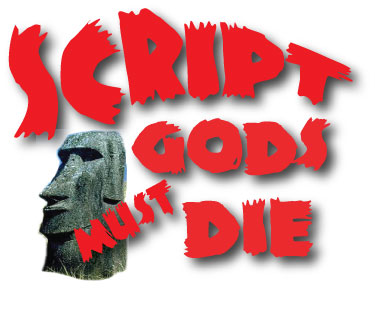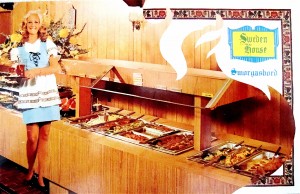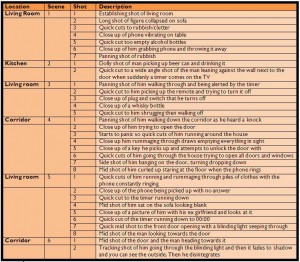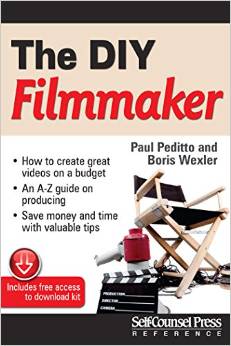I don’t know why I picked this photo to start this post. Sure, the sexy Swede on the left can’t hurt. Closer to the truth though is it reminds me of my all-time fav all-you-can-eat joint in Chicago, the Red Apple. Red Apple is Polish, not Swedish, $20 fish all-in which includes the 20% tip for the Polish gal who served you the Coke and nothing else in an outfit like the one above. Tip her, rise for the Kielbasa and 20 or so sauerkraut pierogis you attempt to ingest, and stumble back out onto Milwaukee Avenue…
All of which has zero to do with format. Format–I haven’t written about it in quite a while. You didn’t miss much. Format isn’t sexy. Never has been, never will be. Hard to get excited about it. Problem is–well, there are lots of problems with a format discussion. Starting with the N O I S E of conflicting advice.
Product and packaging. Content and style. Story and characters will sell your movie. But the packaging has to be there too. And on the internet, there is endless debate on how to package. All I can tell you, Good Reader, is that those who deal in screenwriting absolutes, lie.
There are a million posts on ten thousand websites telling you how to format. These come from self-proclaimed experts to newbies to people with agendas to screenwriting message board trolls with nothing better to do with their afternoons. I don’t know what motivates these people. Me? I’ve got a blog to write and we haven’t talked format in awhile so…let’s talk some basics, what to use or what not to use.
What I’m going to give you are tendencies, stylistic choices. I am not going to tell you your drama must be between 90 and 110 pages. Do I personally try to keep within those bounds? Yes sir, I do. But maybe your story demands more length. The trolls will scream about the The Social Network script weighing in at 161 pages–don’t let page count Nazis stop you from telling your story!!!
True. If Social Network gets 161, so do you…long as you bring the same creative game as Aaron Freakin’ Sorkin–because if you don’t, and you write it at 161, I’m thinking you’ll have plenty of time for those screenwriting message boards.
Story is what sells your movie. Format is the packaging of story. Onto the packaging advice….
- SLUGLINES
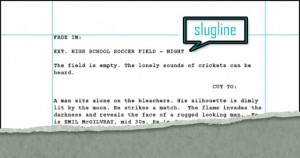 INT. and EXT. don’t need much explaining. Next part is the location. Please, no two line sluglines, keep locations concise. For the third part, time frame, I personally prefer just five of them: DAY, NIGHT, LATER, SAME, CONTINUOUS. These five cover every contingency in your screenplay day. Is DAWN wrong? Nope. How about EARLY AFTERNOON? You can write that too. I’m giving you a stylistic choice. I’m all about moving the reader’s eye down the page, the proverbial fast read. One short word, DAY, instead of two longer words, EARLY AFTERNOON, does that for me. This stuff seems like small potatoes but consider this: You write a hundred or more sluglines per script. The small stuff adds up.
INT. and EXT. don’t need much explaining. Next part is the location. Please, no two line sluglines, keep locations concise. For the third part, time frame, I personally prefer just five of them: DAY, NIGHT, LATER, SAME, CONTINUOUS. These five cover every contingency in your screenplay day. Is DAWN wrong? Nope. How about EARLY AFTERNOON? You can write that too. I’m giving you a stylistic choice. I’m all about moving the reader’s eye down the page, the proverbial fast read. One short word, DAY, instead of two longer words, EARLY AFTERNOON, does that for me. This stuff seems like small potatoes but consider this: You write a hundred or more sluglines per script. The small stuff adds up.
- CAMERA DIRECTIONS
Directing your film in the action lines is amateur hour. Cue the trolls informing me that Birdman, the movie I picked as best of the year is LOADED with camera directions. Not to mention Gangs Of New York, From Russia With Love and God knows how many others dating back to the silent film era. Doesn’t that make it ok if you, Good Reader, want to place a poetic camera angle or two (or twenty) into the script?
Sure, go ahead. What did I say before? No absolutes. And without descending into pointless screenwriting diarrhea debate, let me just point out a common sense fact that Birdman was co-written by the director, an established Hollywood player with major movies to his credit. Is that you? Are you bankrolled and directing the thing? If so, feel free to write those angles into the script itself. If not, why the hell not put them into a SHOT LIST, on the side of the script. If you’re not directing and attract interest in the project, perhaps one day the director will invite you to the meetings with the DP when they put the shot list together. Perhaps, too, the Cubs will win the World Series after 101 years of North Side suffering.
- WE SEE/WE HEAR
 “BLACK. We hear a clock ticking.”– Birdman
“BLACK. We hear a clock ticking.”– Birdman
That’s the script opening of the best movie of the year. So why can’t you use we see/we hear? You can. There are no hard/fast rules concerning we see/hear. It’s a stylistic choice. Would I recommend using them?
Nope.
Why not? I want a screenplay to fly, to not stop the tired eyes of the reader. Action lines by definition are what the camera is seeing and hearing now. Who is in the shot and what is happening. Soooooo….why do I need WE SEE? This isn’t a deal breaker, it’s a head scratcher for me. People say it helps visualize the story. I don’t get the argument. Again, Good Reader, it’s your call.
- WHITE SPACE- 5 LINES PER PARAGRAPH
 Screenwriters have heard this one since their first teething ring. Give white space. Keep action line paragraphs to five and under. Multiple paragraphs are ok but give white space. Develop the cut instinct. Minimize minimize minimize…so why did the writers of Gangs Of New York not get the memo?
Screenwriters have heard this one since their first teething ring. Give white space. Keep action line paragraphs to five and under. Multiple paragraphs are ok but give white space. Develop the cut instinct. Minimize minimize minimize…so why did the writers of Gangs Of New York not get the memo?
Look at these passages…
“Amsterdam grabs the tortoise handle of the knife, PULLS on it. Vallon tries not to cry out. The knife does not move. Amsterdam tries again. He can’t budge the knife. Vallon MOANS. Nearly wild, Amsterdam PULLS with all his strength. Vallon SCREAMS in agony. Amsterdam is pulling so hard he raises his father’s back four inches off the ground. Still the knife will not move. Vallon passes out from the pain. Now, finally, someone steps forward: Monk Eastman. He leans over but Amsterdam, berserk with grief, pushes him away, turns back to his father, and, with a last desperate pull, DRAWS the knife from his father’s heart. He throws it on the ground. Monk picks it up, wipes the blade on his arm, closes the knife and hands it to Amsterdam.”
“As the sun goes down, we have our first full look (MATTE) at the low pale outlines of the city. The harbor is crowded with the high masts of sailing ships. Just north of the island tip is the steeple of the city’s tallest structure, Trinity Church. The buildings of Wall Street are masses of concrete and wood, the streets surrounding them paved with cobblestones. Just above the financial district are the sloping buildings and rutted avenue of the Five Points . The Old Brewery stands tall and forbidding over Paradise Square. Above the Five Points, in the distance, we can glimpse some finer, newer buildings. One wide street–Broadway–seems to run from the very tip of the island clear up into the woods just a few miles north of the harbor. The only SOUNDS are the lapping of the harbor water against the boats, the creaking of masts in the winter WIND.”
Beautiful, sure. But don’t they feel like they’re out of a novel? You’ll need to weigh just how dense you want to make your own screen direction. I’m from the less is more school and would recommend treading lightly here.
- CUT TO
I used to debate stuff like this. I used to have political debates too, but with the acquisition of age, it fell away from my landscape. I remember one such debate with my brother Chris who works for HBO. He, writing his own script, chiding me when I told him to dump every last CUT TO he wrote in his script. Informing me that in his HBO capacity had seen “tons” of scripts that wrote in CUT TO. I, of course, know full well that if you go to Drew’s Script O Rama or SIMPLY SCRIPTS or IMSDB for every ten scripts you’ll find two or three that use CUT TO. So what should you do, Good Reader?
No right or wrong. This isn’t the stuff that’s going to make or break your script.
Would I, personally, recommend using CUT TO?
Hell no.
When it comes time to edit this movie, unless you’re the director you’re not gonna be anywhere near the edit room, so why are you telling me how you would edit it? Because it’s your job as writer to inform me of the movie in your mind? Screw that. A new slugline by definition tells me I’m in a new scene. That’s clarity. How I get from one scene to the next, be it a DISSOLVE or SMASH CUT, is not your call.
Cue the trolls.
